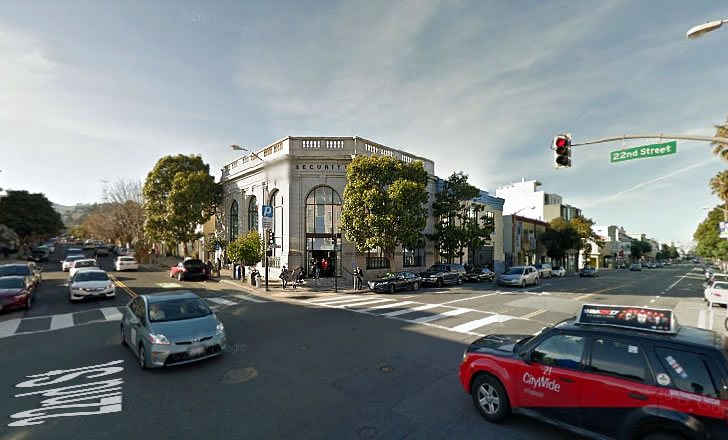Having hit the market last month touting its excellent redevelopment potential, as we first reported at the time, the sale of the historic Hibernia Bank building at 1098 Valencia Street has closed escrow with a $11.898 million contract price.
Designed by Arthur Brown Jr. of Bakewell & Brown and City Hall fame and built for Hibernia Bank in 1924, an addition to the concrete and steel reinforced building on the northwest corner of Valencia and 22nd Street was added along the bank parcel’s Valencia Street frontage in 1995 and the now 12,700-square-foot structure was leased to the government for use by the Social Security Administration which has occupied the building(s) ever since.
Once again, while the GSA’s lease runs through July of 2022, the government doesn’t have an option to renew and the corner site is zoned for development up to 55 feet in height, with housing encouraged above the ground story and no hard limits on the number of units allowed to be constructed based on the size of the lot.
And yes, while original building has been identified as a historic resource, said designation wouldn’t prevent a new building from rising behind its façade.

HIbernia littered SF with these historic builds. There’s at least one more on Market. How many other ones are there ?
Patty Hearst robbed a Hibernia bank on Noriega in the Sunset, but it doesn’t look like much now.
It seems like they had quadruplets (and: yes, they all looked liked this, and yes, they’re all still around)
I had an account with Hibernia for years when this building and the one at Market/McAllister were walk in banks. The one on Market St is gorgeous and has a large stained glass dome. I hear the interior has been restored since the police dept. moved out. The one on Valencia was more subdued but had a simple elegance with it’s high arched windows and chandeliers. I went in it last summer for a social security appointment and not much of the original interior remains.
Let us all offer up in sacrifice to Hestia (the Goddess of Architecture…sort of) the sharpened ends of our 6H pencils, so that the temple will not be defiled.
Unfortunately – and ironically – I think the relatively short limit of 55′ will work against good design here (assuming something is built atop): the building might make a great base for a taller building – 8, 10 stories, whatever – but would look terrible if only two or three floors are piled on it, proportions all wrong.
Let’s raise the height limit then. I’ll write letters, I live in D8.
Completely agree. It would be a great base for even an interesting tower (excuse my profanity).
I anticipate a jenga box rising from inside the preserved facade of the old bank. Ugh.
I don’t think this was bought as a development deal.
55 feet – 20? feet for ground floor retail / existing structure = 35 feet = 4 additional floors if you are lucky. 6,000 sf lot (- 1,200sf circulation) = 4,800sf living space per floor, = 6 units each floor?
So 6 units * 4 new floors = 24 new units, $12mm price so $500K per door for the dirt plus the chance to spend a boatload more to build and preserve? Doesn’t sound right.
I think the trade is more about market office rent with treasury bond credit risk. 12,700sf * $75 per year = @$950K per year. Take away $150k for prop taxes, and say another $150K for everything else = NOI of $650K, or a 5.4 cap on @12mm purchase price.
If the 30 year Treasury is trading at 2.76% then 650K NOI /.0276 discount = a perpetuity value of $23.5mm. Buy the building and get the same income as twice the amount of treasury bonds(!)
My bet here is that the buyer is far more hoping to have a renegotiated market lease agreement with Social Security than face the local Zetas of the lawless development frontier. It’s not worth trying to move product into the area.
i think you’re right on this one. wealth preservation and cash flow from a trade buyer…
Keep in mind, the federal government does not need a renewal option to extend the lease. Even if the lessor did not want to retain the federal government as a tenant upon lease expiration, the Feds could potentially use eminent domain for a leasehold interest if they so desire. Of course, they would have to pay the market rental rate in that scenario.
Do you really find that plausible? Eminent domain can’t be used willy-nilly, it has to be shown that it satisfies a public purpose – specifically one that can’t be met otherwise – and I somehow doubt that paying sky-high rents to have backroom office space for the SSA in some former storefront bank would meet that standard.
Lots of options that don’t involve eminent domain or paying high rents. The SSA could move.
This is class B space, and somehow, I don’t think the Social Security Administration places a premium on the architecture or the foot traffic. It actually makes sense to move this off of Mission as this location may be better suited for a business such as a restaurant that benefits from high foot traffic, while the SSA moves to a location with less foot traffic (e.g. look at DMV) — or better yet, consolidate it into one of the large government buildings around.